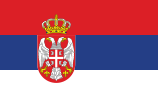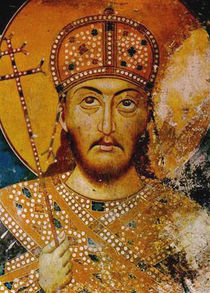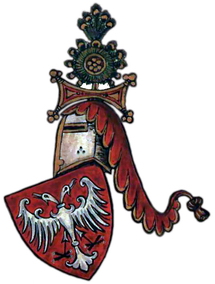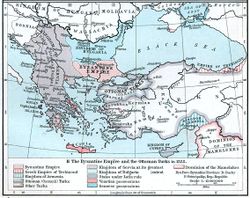Serbian Empire
|
|||||||||||||||||||||||||||||||||||||||
The Serbian Empire (Serbian: Српско Царство, Srpsko Carstvo) was a medieval empire in the Balkans that emerged from the medieval Serbian Kingdom in the 14th century. The Serbian Empire existed from 1346 to 1371.
Contents |
History
| History of Serbia | |
|---|---|
 This article is part of a series |
|
| Prehistoric Serbia | |
| Starčevo · Vinča | |
| Ancient Serbia | |
| Scordisci · Triballi | |
| Roman Serbia | |
| (Illyria; Moesia · Dacia) | |
| Medieval Serbia | |
| Medieval Principality of Serbia (Rascia · Doclea-Zeta Zachlumia · Travunia) |
|
| Medieval Kingdom of Serbia | |
| Serbian Empire | |
| Moravian Serbia | |
| Battle of Kosovo | |
| Serbian Despotate | |
| Ottoman/Habsburg Serbia | |
| First Habsburg Serbia | |
| Second Habsburg Serbia | |
| Great Serb Migrations | |
| Modern Serbia | |
| Revolutionary Serbia | |
| Principality of Serbia | |
| Kingdom of Serbia | |
| Kingdom of Yugoslavia | |
| Nedić regime | |
| Republic of Užice | |
| Socialist Republic of Serbia | |
| Federal Republic of Serbia | |
| Republic of Serbia | |
|
Serbia Portal |

Tsar Dušan, before he came to throne as king of all Serbs, proved himself as a very talented battle leader, who proved himself in the battle of Velbazhd, where Serbia heavily defeated the Bulgarian Empire. As his father was not an able conqueror, Dušan, with the help of Serbian nobility, removed his father from the throne, ordering his people to strangle him. The medieval Serbian state reached its apex in the mid-14th century, during the rule of Stefan Dušan, who proclaimed himself in 1345 tsar in Serres and was crowned in Skopje on the 16th April 1346 as the "Emperor of Serbs and Greeks" by the newly proclaimed Serbian Patriach Joanikie II with the help of the Bulgarian Patriarch Simeon and the Archbishop of Ohrid, Nicholas.
Tsar Dušan enacted Dušan's Code[1] in 1349 and added in 1354. The Code was based on Roman-Byzantine law. The legal transplanting is notable with the articles 171 and 172 of Dušan's Code, which regulated the juridical independence. They were taken from the Byzantine code Basilika (book VII, 1, 16-17). The Code had its roots in the first Serbian constitution — St. Sava's Nomocanon[2][3][4]. from 1219, enacted by Saint Sava. This legal act was well developed. St. Sava's Nomocanon was the compilation of Civil law, based on Roman Law[5][6] and Canon law, based on Ecumenical Councils and its basic purpose was to organize functioning of the young Serbian kingdom and the Serbian church. The Serbian Empire flourished, becominging one of the most developed countries and cultures in Europe.
Tsar Dušan doubled the size of his former kingdom, seizing territories to the south, southeast and east at the expense of Byzantium. He did not fight a single army in the field, instead winning his empire by besieging cities. He was succeeded by his son Stefan Uroš V, called the Weak, a term that might also apply to the state of the empire, as it slowly slid into feudal anarchy. The combination of sudden conquest, backwards administration, and failure to consolidate his holdings led to the fragmenting of the empire. This is a period marked by the rise of a new threat: the Ottoman Turkish sultanate gradually spreading from Asia to Europe and conquering Byzantium first, and then the other Balkans states. Too incompetent to sustain the great empire created by his father, Stefan V could neither repel attacks of foreign enemies, nor combat the independence of his nobility. The Serbian Empire of Stefan Uroš fragmented into a conglomeration of principalities, some of which did not even nominally acknowledge his rule. Stefan Uroš V died childless in December 1371, after much of the Serbian nobility had been destroyed by the Turks in the Battle of Maritsa earlier that year.
Tsars
- Stefan Uroš IV (1346–1355)
- Stefan Uroš V (1355–1371)
See also
- Zakonopravilo
- Dušan's Code
- Simeon Uroš
- John Uroš
- Serbian Despotate
- Serbia in the Middle Ages
- History of Serbia
- Corpus Juris Civilis
References
- John V.A. Fine, Jr., The Late Medieval Balkans, Ann Arbor, 1987.
- George C. Soulis, The Serbs and Byzantium during the reign of Emperor Stephen Dusan (1331–1355) and his successors, Athens, 1995. ISBN 0-88402-137-8


